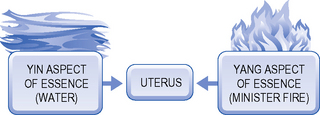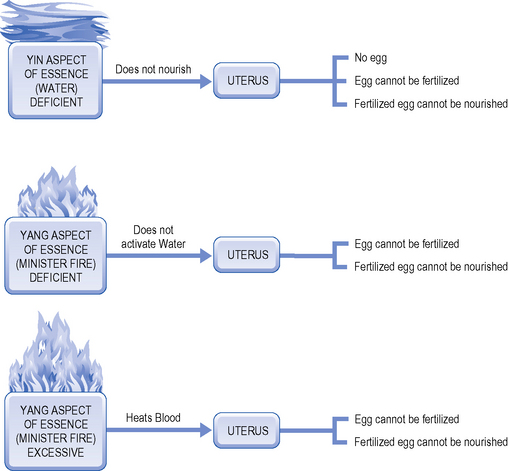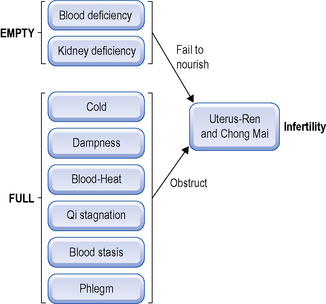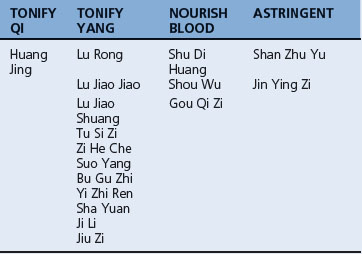Chapter 57 Infertility
Aetiology
Pathology
When discussing the pathology of infertility, there are various aspects to consider:
Full versus Empty causes of infertility
Empty conditions
Whether it is a deficiency of Kidney-Yin or Kidney-Yang, the Kidney-Essence is always involved in its Yin or Yang aspect. As discussed in Chapter 2 on physiology, the menstrual function and the Uterus rely on the Yin aspect (which is Post-Natal) and on the Yang aspect of the Essence (which is Pre-Natal). The Yang aspect of the Essence is the Fire of the Gate of Life, also called the Minister Fire, that is formed at conception.
As we have seen in Chapter 2, the Minister Fire is of a special type: a ‘formless’ Fire, it can actually generate Water (rather than drying it up). For fertilization to occur, the Yin and Yang aspects of the Essence need to be perfectly balanced: the Yin in the form of Water, Essence and Blood is the substantial basis for conception to occur, but the Yin needs the warming and fertilizing action of Yang, in the form of Minister Fire.
If the Water, i.e. the Yin aspect, is deficient, there is not enough nourishment to support the fertilized egg (or to produce an egg at all); if the Minister Fire is deficient, there is no ‘spark’ to transform and activate the Water, which therefore cannot fertilize or nourish an egg. Vice versa, if the Minister Fire is excessive and pathological, the Blood in the Uterus may become hot and this creates adverse conditions for the fertilization or support of an egg. Figures 57.1 and 57.2 illustrate these concepts.
Full conditions
Dampness, to which women are particularly prone, invades the body from the Lower Burner. It prevents the proper movement of Qi and Blood and may therefore lead to stagnation of Qi and/or stasis of Blood. Unable to function properly, the Directing and Penetrating Vessels (Ren and Chong Mai) cannot gather the Essence for the woman to conceive. From a channel perspective, this may due also to a pathology of the Girdle Vessel (Dai Mai) affecting the Directing Vessel (see Ch. 7). From a Western perspective, Damp-Heat often corresponds to pelvic or tubal inflammation.
Phlegm may cause infertility by obstructing the Uterus and its channels so that the Directing and Penetrating Vessels cannot function properly and the Essence cannot be gathered. Zhu Dan Xi (1281–1358) says in his The Heart and Essence Dan Xi’s Methods of Treatment: “Inability to conceive in fat women is caused by the Fat [i.e. Phlegm] within the body blocking the Uterus.”1 This is an interesting statement because polycystic ovary syndrome, a major cause of infertility, often occurs in obese women. Modern Chinese doctors relate obesity to Phlegm. Damp-Phlegm is nearly always the main pathogenic factor in polycystic ovary syndrome.
The Directing and Penetrating Vessels in infertility
No matter whether the condition is Full or Empty, in infertility the Uterus and the Directing and Penetrating Vessels (Ren and Chong Mai) are obviously always involved. In case of deficiency, the Uterus and the Directing and Penetrating Vessels lack the necessary nourishment to nurture the fertilized egg or to produce an egg at all; in the case of excess, pathogenic factors obstruct these structures and prevent their proper Qi, Blood and Essence transformation so that fertilization or implantation cannot occur (Fig. 57.3).
The cervical secretion
When treating infertility, one must always take into consideration the cervical secretion that occurs just before ovulation and that indicates fertility. As discussed in Chapter 2, the cervical secretion is a direct manifestation of Kidney-Essence and its absence (or short duration of 1 day only) indicates a deficiency of Kidney-Essence and a weakness of the proliferative phase. Therefore, one must always ask a woman seeking treatment for infertility to check the cervical secretion every month.
The basal body temperature
The second sign that one must consider is the basal body temperature (BBT) also discussed in Chapter 2. Although the BBT does not give us indications for treatment as the spike in temperature occurs after ovulation, it is important to chart the temperature every month to monitor the progress (or lack of it) of the treatment. If a previously flat chart starts to develop the typical biphasic shape, it is obviously a very good sign. It is also very encouraging for the patients to see the objective improvement in the chart for themselves.
Identification of patterns and treatment
Infertility is frequently treated in China according to the four phases of the menstrual cycle as described in Chapter 2, i.e. the period, the post-menstrual, the inter-menstrual and the pre-menstrual phases. The treatment principles in each phase are as follows:
Dr Li recommends the following treatment principles for the above four phases:
The patterns discussed are as follows:
Herbs that nourish the Kidney-Essence
Before discussing the differentiation and treatment of infertility, it is useful to review the herbs that nourish the Kidney-Essence. There is no separate category for Essence-nourishing herbs and they can be found in various categories. Most of them are in the Kidney-Yang tonics category. Some of them ‘stabilize’ the Essence rather than nourish it but they are often combined with Essence-nourishing herbs: for example, Bu Gu Zhi Fructus Psoraleae or Yi Zhi Ren Fructus Alpiniae oxyphyllae. ‘Stabilizing’ the Essence implies an astringent action that is used with symptoms such as nocturnal emissions or spermatorrhoea in men and chronic vaginal discharge in women. A list of herbs that nourish the Essence by category is given in Table 57.1
Nourishing the Essence is essential in infertility, especially of the deficient kind, and particularly that from Kidney deficiency. The majority of these cases of infertility are due to an ovulatory dysfunction and ovulation is an expression of the transformation of the Kidney-Essence into ova. Thus, to promote ovulation, it is necessary to nourish the Essence. Nourishing the Essence transcends tonification of Yin or Yang as the Essence itself has a Yin and a Yang aspect. Its Yang aspect is the Minister Fire which is present from conception, and its Yin aspect is the Essence itself that, at puberty, crystallizes into menstrual Blood and the ova (see Fig. 4.3). Given the importance of the role of the Minister Fire in transforming the Tian Gui into menstrual blood and ova, it is interesting to note that the majority of herbs that nourish the Essence are in the Kidney-Yang tonics category. Some of the herbs listed in Table 57.1 deserve particular comment.
Herb combinations for infertility
Some herb combinations are used particularly frequently in infertility.
Combinations for deficiency conditions
Combinations for excess conditions
Chuan Lian Zi Fructus Toosendan and Lu Lu Tong Fructus Liquidambaris
This combination can be used for tubal obstruction: it moves Liver-Qi and invigorates Blood.
Empty conditions
Kidney-Yang deficiency
Treatment principle
Tonify and warm Kidney-Yang, stoke up the Fire of the Gate of Life, strengthen the Uterus.
Acupuncture
Explanation
Special moxibustion prescription
A special moxibustion method for infertility from Kidney-Yang deficiency consists in using moxa on Ren-8 Shenque. The method is as follows: take 2.5 g of moxa wool and add 1 g each of powdered Chuan Jiao Pericarpium Zanthoxyli and Xi Xin Herba Asari, and wet the mixture with a saline solution. Make into a paste. Place this paste in the umbilicus, cover with a thin slice of fresh ginger and apply moxibustion to it with a moxa stick for 30 minutes. After that, leave the paste in the umbilicus, cover with a plaster and remove after 24 hours. Repeat the same procedure for 10 successive days.6
Herbal treatment
a. Prescription
Explanation
b. Prescription
c. Prescription
d. Prescription
Formula I (for 7 days after the period)
Formula II (for 8 days during ovulation)
Table 57.2 compares and contrasts the formulae for infertility from Kidney-Yang deficiency.
Women’s Treasure remedy
Diagnosis
There are two main patterns: one is Blood deficiency and the other Kidney-Yang deficiency. The symptoms of Blood deficiency are dull and pale complexion, floaters, scanty periods, dull headaches on the vertex, Choppy pulse and Pale tongue. The manifestations of Kidney-Yang deficiency are feeling cold, cold feet, occasional tinnitus, Weak Kidney pulses and Swollen tongue. I relate allergic rhinitis also to a Kidney-Yang deficiency and specifically a deficiency of what I call ‘Kidney Defensive Qi system’ (see Ch. 6 of the Practice of Chinese Medicine8). From a channel point of view, allergic rhinitis also involves a weakness of the Governing Vessel, which is consistent with a deficiency of Kidney-Yang. On the other hand, the Blood and Kidney-Yang deficiency involves a deficiency of the Directing and Penetrating Vessels: thus, in her case, there is a deficiency of the three main Extraordinary Vessels that control fertility, conception and pregnancy.
Explanation
Kidney-Yin deficiency
Acupuncture
Herbal treatment
b Prescription
c. Prescription
Blood deficiency
Herbal treatment
Women’s Treasure remedies








